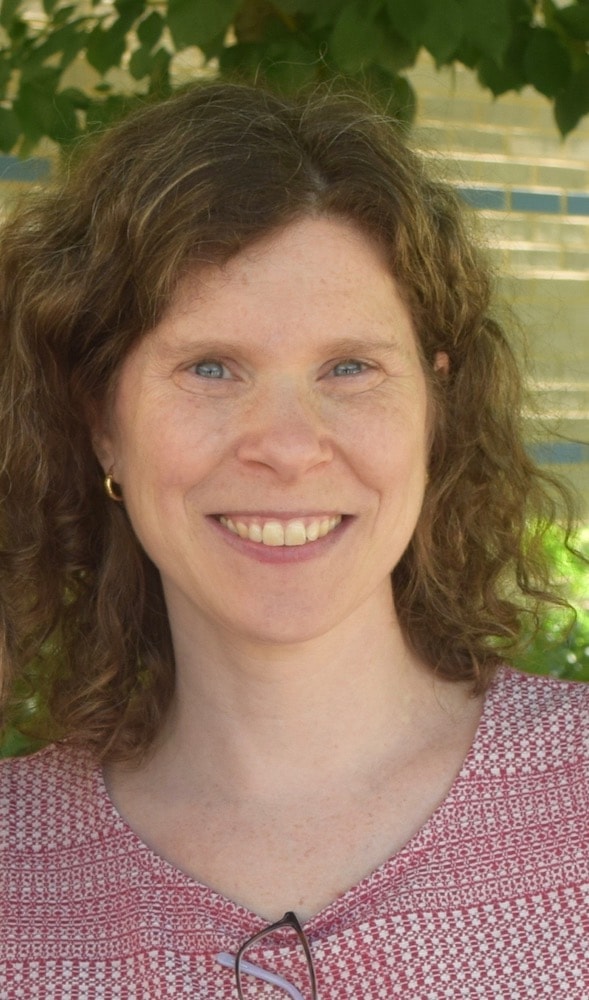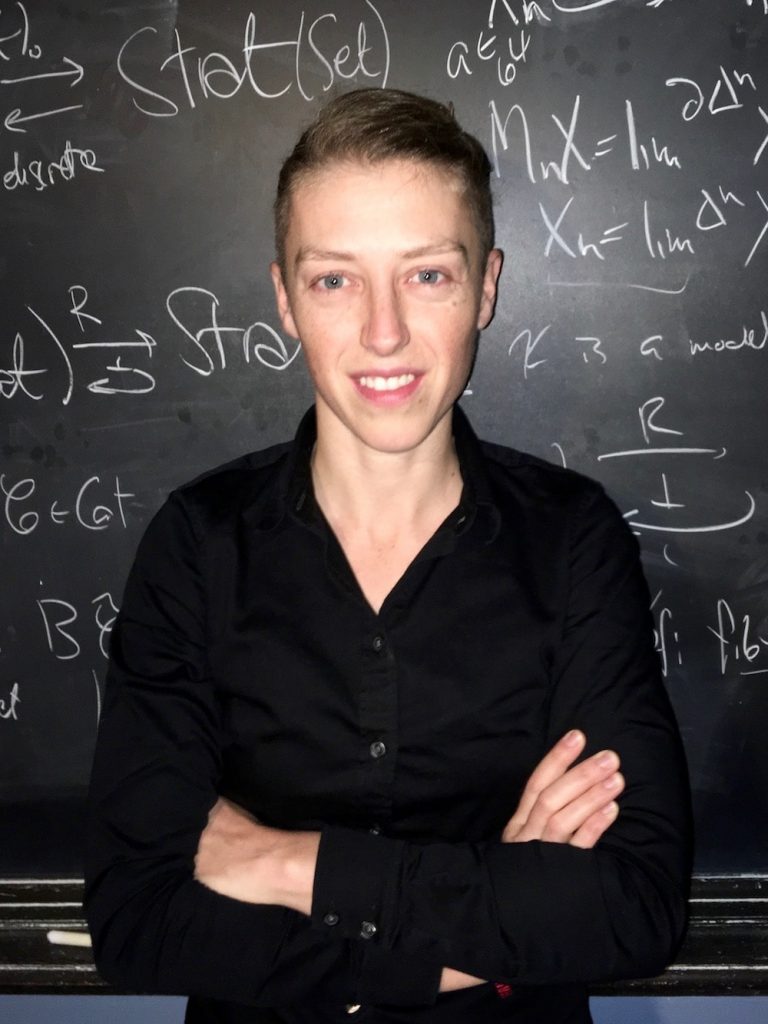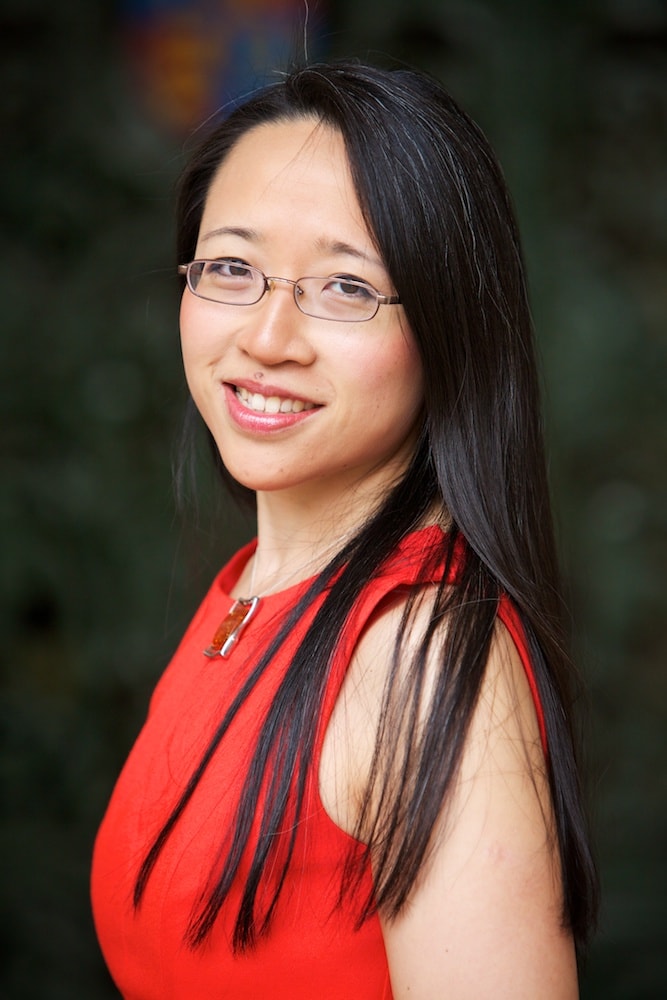The Women Taking Math To The Next Dimension
Rebecca Goldin, Emily Riehl, and Eugenia Cheng share their favorite puzzles, explain why math is like a dragon, and give tips for young women entering the field.
You may associate math with calculators or multiplication tables on a chalkboard. But it actually reaches to much higher dimensions—extending far beyond the physical world. It may sound difficult to study something that you cannot visualize or touch, but mathematicians see math as a world with limitless possibilities, according to mathematician Eugenia Cheng.
“The great thing is that we’re not constrained by physical reality; we’re only constrained by our own imagination,” Cheng told SciFri in a recent interview. “So if you have a huge imagination, that means you have a huge capacity for thinking about mathematics.”
In fact, we are naturally wired to accept the imaginary. For instance, even though the value of pi and negative numbers don’t have concrete objects ascribed to them, “our minds are kind of setup to understand math in a much broader sense than just that it has to be physically there and physically present,” explained Rebecca Goldin, a mathematician at George Mason University.
And if you think these concepts go over your head, you aren’t alone. “None of us really understands it, honestly,” said Cheng. “We are just trying to understand it more all the time.”
On last week’s celebration of women working on advanced math, Rebecca Goldin, Emily Riehl, and Eugenia Cheng discussed some of the latest discoveries in math, as well as debunked some of the tropes of the profession. SciFri reached out to the three mathematicians to continue the conversation—expounding on mathematical puzzles, the collaborative environment, and mythical representations on the subject.

Professor, George Mason University
Describe what you study in one sentence.
I study geometry, and the symmetries of geometric interactions.
What is your favorite math story or puzzle?
Hard one! My favorite math story might be that of the Middle Ages Italian mathematician, Fibonacci, who discovered a pattern in the number of rabbit pairs he would have as they start to mate. He started with one pair in the first mating period, and assumed they would mate but don’t yet have babies in the second period. In the next mating period, they have a pair of babies, creating now a total of two pairs of rabbits. From there, we imagine that it takes two mating periods from when baby rabbits are born to when they mate and have baby rabbits of their own, but then they continue to mate every mating period. Each cycle, the number of rabbit pairs increases, and with this pattern: 1 pair, 1 pair (no babies yet), 2 pairs (of which one is a baby pair), 3 pairs (the original pair of rabbits have a new pair of babies), 5 pairs (original parents have a new pair and the first babies, born two months ago, now have babies, creating a new pair).
As it goes on, the numbers keep adding in pairs (yes, like the rabbits!) so each number in the sequence is the sum of the two numbers prior. That’s because the rabbits that existed two months prior are the ones having new babies!
“When I was young, I thought it was all about tedious computations, that just got more advanced but not more interesting. In contrast, math is playful, colorful, and conceptual.”
What do you love most about math?
In a practical way, I absolutely love the puzzle aspect of math! It can be obsessive and frustrating but so rewarding. But I also love how beautiful it is. Many powerful mathematical results are just visually stunning to imagine in my mind.
What surprised you most about being a mathematician?
I was probably most surprised by what mathematics is. When I was young, I thought it was all about tedious computations, that just got more advanced but not more interesting. In contrast, math is playful, colorful, and conceptual.
What advice do you have for young women who want to become mathematicians?
My advice for young women depends a lot on their place in life. To high school and college women, I say: Go for it! You can do many things with a degree in math and you don’t have to have it all figured out before you get the degree. When you’re close to finishing your degree, you can start to plan what kind of career you want, whether it be in industry or academia or government. To women in their 30s, I might say: If you want a kid, have one! Don’t let the image of “sacrifice” involved with doing math impede your plans to do other things with your life as well.
What is your favorite math-related pun?
What do you get when you cross a mosquito with a mountain climber?
Answer: You can’t cross a vector with a scalar (those people who have studied multivariable calculus will groan…).
If math were a mythical creature, what would it be?
A dragon first pops to mind. Huge, powerful, scary, beautiful, fire-breathing, something you want to own but can’t. It’s a creature whose strength is not entirely known.

Assistant Professor, Johns Hopkins University
Describe what you study in one sentence.
I am working with the theory of infinite-dimensional categories, which functions as a linguistic template for mathematicians to study objects that are related not just by the usual functions, but also by functions between these functions and functions between these functions between these functions ad infinitum.
What is your favorite math story or puzzle?
One of my favorite theorems is the Banach-Tarski paradox, which says that a three-dimensional ball can be disassembled into five pieces, which can then be translated and rotated and reassembled to form two disjoint copies of the ball, each of which have the same size as the original. This is totally wild, but follows irrefutably from the “axiom of choice” which most mathematicians accept as use in their work. (I’m certainly pro choice.)
What do you love most about math?
I love feeling like I’ve really understood something—which typically comes years after first vaguely understanding that thing. An example from my field is something called the Yoneda lemma, which is really the fundamental result in category theory. I learned its statement and proof in the first year of graduate school but it wasn’t until several years later that I finally began to grasp its real implications, that relationships between “universal properties”—theorems that are true in any imaginable category of mathematical objects—can be calculated just by considering sets and functions. Then this vast generalization, from sets to anything, follows by applying the Yoneda lemma.
What surprised you most about being a mathematician?
I was surprised by how social mathematics can be. Nearly all of my research papers are written with one or more collaborators (one of which includes Eugenia!). And mathematicians travel all the time so that we can talk to each other in person about areas of common interest.
What advice do you have for young women who want to become mathematicians?
Ask questions! When I was younger I used to be embarrassed about asking questions because it revealed that I didn’t know everything already. But what it really reveals is that you’re thinking, and it’s by far the best way for you (and often also the person you are quizzing) to learn something.
What is your favorite math-related pun?
The puns I like to use while lecturing are spontaneously generated and very seldom funny out of context (or even in context, but hey, it’s the effort that counts). But I’ll share my favorite mathematical joke:
A physicist, biologist, and mathematician see two people walk into an abandoned building across the street. Some time later, much to their surprise, three people emerge from the building, and they wonder how they might explain this phenomenon. The physicist declares, “Our initial observation must have been incorrect.’’ The biologist then speculates that, “they must have reproduced.”
Finally, the mathematician pipes up: “Now if one person walked into the building it would be empty!”
If math were a mythical creature, what would it be?
I think of math as something of a phoenix. Mathematicians still use theorems that were proven centuries or even millennia ago. But at the same time, the way we interpret these arguments has completely transformed to the extent that our basic intuitions would be completely unrecognizable to past mathematical pioneers.

Scientist in Residence at the School of the Art Institute of Chicago
Describe what you study in one sentence.
I study category theory, a branch of “very abstract” algebra, which I call the mathematics of mathematics.
What is your favorite math story or puzzle?
I like the story of how people tried to prove Euclid’s parallel line postulate by contradiction (from the other axioms) and found that there was in fact no contradiction, and they ended up inventing different types of non-Euclidean geometry instead.
What do you love most about math?
I love the fact that it is fundamental, that it relies only on logic, that it explains things, and that it doesn’t require you to believe anyone. I like the fact that it uses no equipment except my brain, and that it involves creativity and imagination as well as sheer intellectual power.
What surprised you most about being a mathematician?
I’m a bit baffled by the fact that I’ve reached the age I’m at and I still think better while eating chocolate. However, nothing really exactly “surprised” me, because becoming a mathematician happens very gradually over years, and so it’s not as if you “become” a mathematician one day and see what this new life is like.
“I like the fact that it uses no equipment except my brain, and that it involves creativity and imagination as well as sheer intellectual power.”
What advice do you have for young women who want to become mathematicians?
You don’t have to emulate the behavior of male mathematicians in order to be successful. Actually, this is my advice to young women who want to become anything. But also, you can have male role models, you don’t have to have female ones. Because women can be anything that men can be.
What is your favorite math-related pun?
I suppose, given the title of my first book, How to Bake π, I’ll have to say it’s pi(e).
But maybe it’s actually something esoteric and category-related, like “Did you hear about the category theorist who couldn’t prove that a function was surjective? Epic fail.” That’s probably not funny to many people.
If math were a mythical creature, what would it be?
I refer to the Loch Ness Monster in my book Beyond Infinity. People argue about whether it (math or the monster) exists or not, but in a way it doesn’t matter: The idea of it exists. We see dark shadows or ripples on the surface of the water and we want to know what caused those effects.
These interviews have been edited for length and clarity.
Lauren J. Young was Science Friday’s digital producer. When she’s not shelving books as a library assistant, she’s adding to her impressive Pez dispenser collection.